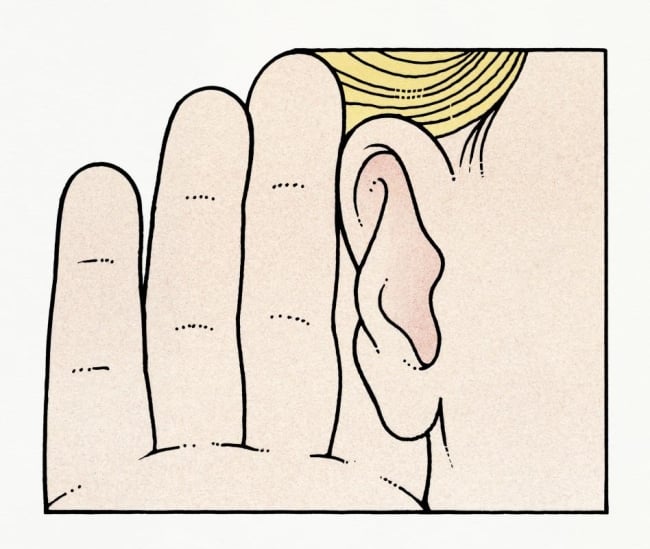You have /5 articles left.
Sign up for a free account or log in.

Dorling Kindersley/getty images
Like many professors, I missed being on campus last year. Teaching is a performative art, and online instruction too often features a talking head addressing comments to thumbnail portraits of students. It just isn’t the same as interacting with people a few feet away.
But as much as I’ve looked forward to teaching in the classroom, one aspect I’ve worried about was oral participation -- and not without reason. This time around, I’m straining to hear masked, soft-spoken, socially distanced students speaking against the noise of the beefed-up HVAC system.
I’m not the only anxious one. When I polled other faculty members about this issue via a campus Listserv, I received an overwhelming response. As one professor noted, “I have a slight hearing problem anyway. All this is making it impossible to understand even the ones up front.”
Another professor, a Spanish teacher, told me, “At least on Zoom, I could hear everyone clearly. They even had little name identifiers at the bottom of their pictures.”
In short, professors forced to teach online learned to appreciate some of its advantages. A few students grew fond of remote learning, too.
In fact, some teachers had the same trouble pre-pandemic, including those with profound hearing loss: “I can get the gist by lipreading,” a professor with accident-related deafness said, “but that’s not possible when someone’s covered their face.” Would clear-fronted masks help? Maybe, but I don’t see anyone on campus wearing one.
Pandemic issues aside, age-related hearing problems are a tough obstacle that’s just going to get worse. Aging baby boomers, people with medical conditions or just those who’ve listened to too much loud rock music are inclined to say, “What?” or possibly fake comprehension.
What goes first is the ability to distinguish sounds in the upper range, or high-frequency hearing loss. Consonants like f, s and h, spoken at a higher pitch than other sounds, tend to blur. So speech may sound muddied, especially against other noise. People with this type of hearing loss can hear but not always comprehend.
Full confession: now in my 60s, I’ve started wearing hearing aids for exactly this reason. But even the most powerful, sophisticated hearing aids don’t cover distance well or deal with multiple voices or ambient noise. They’re fine for close conversation between two people, slightly hellish in a crowded restaurant and beleaguered when competing with a loud ventilation system. When a student says, “I found the last story hard to understand,” I may hear something on the order of, “The sound of the laugh story hard I can’t stand.” One professor in our English department retired a few years ago because, as he said, “I simply couldn’t make out what the students were saying.”
So what can be done? First of all, information technology and audiovisual departments are used to dealing with the opposite problem: students who can’t hear the instructor in the front of the room. To remedy that problem, a microphone and amplifier are generally all that’s required. But when the situation is reversed, the solution isn’t that simple. A few colleagues at other institutions have thought about a portable mike -- and discarded the idea. “My students don’t want to pass around a microphone during COVID,” one veteran professor told me. “And the delay would hamper discussion.” The same hitch applies to a standing microphone: the lag in approaching and leaving impedes any kind of real-time conversation. You also can’t distribute as many individual microphones as there are students, and even if you could, there are feedback issues.
Has the 21st century brought us nothing? As it turns out, some smart classrooms feature built-in microphones behind the desks. One of our IT/AV people told me that, in a few of the larger lecture halls, every other seat used to have a microphone. Yet through either vandalism or carelessness -- book bags slammed down, cables kicked -- the microphones were disabled. And when they were repaired or replaced, the same thing happened. He said that there might be plans to hang microphones from the ceiling but didn’t know when. Meanwhile, the cost for retooling the average classroom that way would be prohibitive.
The worst part is that merely amplifying a voice doesn’t help much with high-frequency loss. As one hearing and cognition expert notes, “You have to think of it this way: microphones just amplify the input. If the input is bad, it will not improve the quality. Then add the characteristics of the listener to it. If the person has a high-frequency hearing loss, they will hear the input as it comes in -- high quality or not -- and then the microphone will not adjust for the high frequencies that are missing for the listener. If that worked, nobody would have needed to develop hearing aids in the first place. Hearing aids are not just amplifiers. They have complex algorithms in them that correct the incoming signal according to what the listener needs.”
This explanation makes a great deal of sense as to where the problem lies. A room set up as a giant, multidirectional hearing aid reconfigurable for each new class may sound chimerical, but hearing loops, which use magnetism to reproduce an entire room’s audio output sent directly to a hearing aid, are already in use in some theaters and concert halls. Unfortunately, the price for even a conference room may be around $2,500 to $4,000.
IT/AV services are still trying to come up with solutions. As the AV manager where I teach noted, they’re looking into “the rooms that have ceiling microphones intended for use in distance learning. While the ceiling microphones do not reinforce directly to the room speakers, they could be used as a means to provide input to Google Slides with live transcription active, which would provide a written transcript of the speech picked up by the microphones in the room.”
Some better-endowed institutions have already adopted live captioning. For in-person transcripts while people are speaking, for instance, I've been told that one top Ivy League university outsources CART (computer-assisted realtime transcription) through the service TotalCaptioning. As a contact there informed me, “These services are extremely expensive. Our office’s budget has been entirely rearranged since the pandemic began.”
Prospecting for other, cheaper methods to deliver aural clarity may lead to dubious purchases. The internet, which offers everything, does have a few sites that talk about teachers with hearing issues, but items like Voice Tracker and a “super-directional microphone plugged into a PockeTalker” seem more wishful thinking and merchandising than effective technology.
Who else on campus can help? Disability services offices are aware of this problem, though again, the focus is generally on serving students rather than faculty. Suggestions from our Disability Resources Center are well meant but too hard to implement or ineffective in this situation: “Some classroom modifications may be helpful. Examples include: limiting your class size to allow easier communication; assigning your course in a location with minimal additional noise (HVAC equipment, away from the main entrance/exit, etc.); using an array microphone that captures the voices of multiple speakers in a small group setting (IT may be able to help with this); or allowing written communication or instant messaging when possible.”
I’ve taught courses with an ASL interpreter at the front of the class for a student whose hearing was fading. I don’t know sign language and could possibly learn, but not for this fall, and in any event, watching a signer while fielding a query from someone in the back who’s just raised their hand would be a challenge. I’ve also had students who required a professional note taker -- again, not an option for me. Voice-recognition software, growing better every year, can handle some voices that need to be recognized. I’m glad these accommodations exist, and I hope they continue to improve.
Meanwhile, what measures can the rest of us take?
I don’t want to ask students to unmask or sit closer to the front (and to each other) than they feel comfortable doing. I once asked our facilities department, pre-pandemic, to turn down the ventilation system, which in this particular classroom sounded like a wind tunnel. But it still made noise, and after a while, the air grew stagnant -- certainly not a condition you’d want when dealing with airborne contagion.
One friend, a doctor who teaches at a major hospital, proposed this idea: “Ask every student to bring a laptop or cellphone with a Zoom application. When a student has something to say, they’ll raise their hand, and you call on them. Then they unmute their microphone and speak into their device. The sound gets transmitted to everyone else’s device, including yours.” This proposal has the great advantage of using what most students in the classroom already have, though it partly defeats the atmosphere of in-person teaching. Also, when I tried it out, the proximity of all those laptops created an echo effect.
So what’s the best solution? Maybe confronting the issue head-on or, to mix a metaphor, on the ground. When I talked to a veteran teacher who’s been partially deaf since childhood, she had this to say: “I go up to them the first day of class. I request that they speak slowly, loudly and clearly. I tell them, ‘You’ll thank me for this during your first job interview.’”
You know, that just might work.








